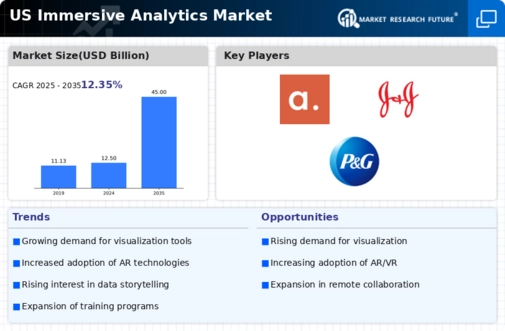The immersive analytics market is currently characterized by a dynamic competitive landscape, driven by rapid technological advancements and increasing demand for data visualization tools. Key players such as Microsoft (US), IBM (US), and Tableau (US) are at the forefront, leveraging their extensive resources to innovate and enhance their offerings. Microsoft (US) focuses on integrating immersive analytics into its Azure cloud platform, thereby facilitating seamless data interaction and visualization. IBM (US) emphasizes its AI capabilities, particularly through its Watson platform, to provide advanced analytics solutions that cater to diverse industries. Tableau (US) continues to enhance its user experience by incorporating augmented reality features, which allows users to interact with data in more intuitive ways. Collectively, these strategies not only bolster their market positions but also intensify competition, as companies strive to differentiate themselves through innovation and customer-centric solutions.
In terms of business tactics, companies are increasingly localizing their operations and optimizing supply chains to enhance efficiency and responsiveness. The immersive analytics market appears moderately fragmented, with a mix of established players and emerging startups. This structure allows for a diverse range of solutions, although the influence of major players like Oracle (US) and Qlik (SE) remains substantial. Oracle (US) is particularly focused on expanding its cloud-based analytics services, which positions it well against competitors, while Qlik (SE) is enhancing its data integration capabilities to provide a more comprehensive analytics experience.
In October 2025, Microsoft (US) announced a strategic partnership with a leading virtual reality firm to enhance its immersive analytics capabilities. This collaboration is expected to integrate advanced VR technologies into Microsoft’s existing analytics tools, thereby providing users with a more engaging and interactive data visualization experience. The strategic importance of this partnership lies in its potential to attract a broader user base, particularly among industries that rely heavily on immersive technologies, such as healthcare and education.
In September 2025, IBM (US) launched a new suite of AI-driven analytics tools aimed at small to medium-sized enterprises (SMEs). This initiative is significant as it democratizes access to advanced analytics, allowing smaller businesses to leverage data insights that were previously available only to larger corporations. By targeting SMEs, IBM (US) not only expands its market reach but also fosters innovation across various sectors, potentially leading to increased competition in the analytics space.
In August 2025, Tableau (US) unveiled a new feature that allows users to create interactive dashboards using natural language processing. This development is crucial as it simplifies the data analysis process, making it accessible to non-technical users. The strategic move reflects Tableau’s commitment to enhancing user experience and broadening its customer base, which is essential in a market where ease of use is increasingly valued.
As of November 2025, the immersive analytics market is witnessing trends that emphasize digitalization, sustainability, and the integration of AI technologies. Strategic alliances are becoming more prevalent, as companies recognize the need to collaborate to enhance their technological capabilities and market reach. Looking ahead, competitive differentiation is likely to evolve, shifting from traditional price-based competition to a focus on innovation, technological advancement, and supply chain reliability. This transition suggests that companies that prioritize these aspects will be better positioned to thrive in an increasingly competitive landscape.

















Leave a Comment